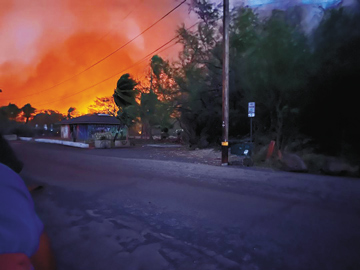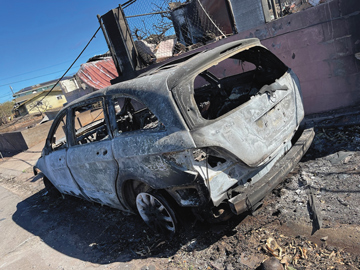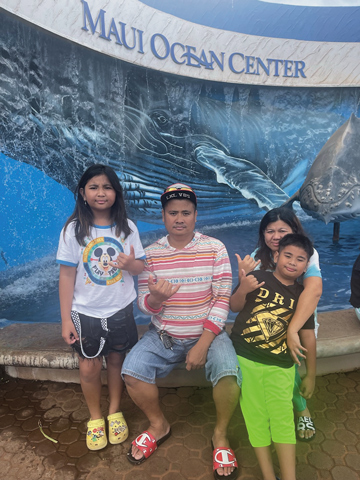Hopes, Dreams and Challenges
Alfredo G. Evangelista | Assistant Editor
Traditionally, on December 31, local clans gather to celebrate the coming of the new year. Families and friends gather over a feast that may include lechon, sashimi, poke, BBQ, noodles, mochi, suman and my favorite Pinoy dessert, tupig. And our kababayan are scrambling to complete their Prosperity Plate of Fruit. (Is it twelve round fruits for each month or thirteen, with one for good luck?) And yes, fireworks to scare away all the bad spirits. At the stroke of midnight, champagne is popped, cars are started, all lights are turned on, folks jump for joy, and hugs and kisses all around. And then later, the fireworks are cleaned but leaving some red paper for good luck (at least that is what my Chinese neighbor used to tell me about scraps that ended on our yard and driveway).
But for the Lahaina fire survivors, the celebration was understandably generally less festive. With the devastation of Lahaina and the loss of life, property and lifestyle, how could one actually celebrate?

Photo courtesy Rose Ann Misay
For Lahaina fire survivor Kai Pelayo and his family, they celebrated New Years Eve with their family. “We were at our house,” says Pelayo. “It was more muted but we celebrated through our grandchildren—the joy of seeing them run around and act as children. We celebrated life through their eyes. A lot of the adults were remembering times past but my grandchildren still can find joy.”
Pelayo explained how in his neighborhood in the Wahikuli area, folks came back to their homes on New Years Eve, even though smoke and ash damage to their homes still made them unlivable.
Pelayo, who lived through Hurricanes Iwa and Iniki on Kaua‘i, considers his family to be one of the more fortunate ones. Only 20 percent of the roof of his home suffered damage. While insurance covered only repair of the damage, he has gone ahead and replaced the roof.

Photo courtesy Kai Pelayo
But on the night of the Lahaina fire, Pelayo had no expectations of that fortunate result. Pelayo and his family fled to escape the fire and find shelter like other Lahaina residents. “At 9:45 p.m., my wife came upstairs and we could see the fire jump the stream,” Pelayo recounts. “We knew we had to go so we started to put things together. Five minutes later, we knew we didn’t have time. As we were driving, we could see the end of the street. We saw the blue lights of the police car before we even saw the car. We heard the police [announcing over their car loudspeakers:] ‘Get out’.”
Pelayo recalled staying barely ahead of walls of smoke that would have made roadway visibility challenging. Pelayo and his family ended in the parking lot of the Lahaina post office at the Civic Center before they had to relocate when the fire threatened that shelter site as well.

Photo courtesy Kai Pelayo
Sixty-eight-year-old Karl Casco was at home on Malo Street with three of his family members when the police arrived at their home to have them evacuate. Casco was able to drive to a safe location.
Rose Ann Misay was working at the time of the fire while her husband, her eleven-year-old daughter and seven-year-old son were at home. At 3 p.m., Rose Ann’s family told her when they opened the window, the fire was already at their neighbor’s house. “They escaped the fire right away,” said Misay. “But due to the high winds, they were trapped in traffic so what they did was to leave our car at Ace Hardware and walk from there to the Lahaina Civic Center. But when they were there, someone said it was not the place for a shelter so they walked along the highway towards Kä‘anapali together with my Mom, all barefooted. It’s a good thing they saw our neighbor pass by so they rode in our neighbor’s car to the Ritz Carlton.”
Casco and Misay lost everything in the fire. “We are so affected by this fire because all our belongings, memories, cash, jewelries are gone,” says Misay. “It’s very depressing and painful, especially seeing my kids going through this devastation.” Many Lahaina survivors remain hesitant to share their stories of escape and survival. But while adults are often crying, “the kids are looking at it through their eyes of innocence,” observes Pelayo. “Some of them are losing their innocence because of this.”

Photo courtesy Kai Pelayo
In addition to losing their homes, thousands of Lahaina fire survivors are still sheltering in hotel rooms and their future housing prospects continue to be in flux.
During the second Tulong for Lahaina® Distribution on December 3, 2023, recipients were asked to complete a confidential survey. In responding to the question about their housing situation, many responded they had to move. One recipient noted their family had to move at last minute notice while another family stated it was their fifth time to change hotels. One survivor said they had to move because the owners wanted to rent their unit to a guest. Another survivor simply commented, “When are they going to kick us out?”
Casco knows his family can stay in the condominium for one year; another survivor is in a rental house for one year, with the rent paid by their insurance company. Another family found a studio but so far has not received any rental assistance.

Photo courtesy Rose Ann Misay
Others continue to search for affordable housing or a place to accommodate their pets. As one survivor observed “There’s not a lot of choices and its expensive.”
Like almost everyone who completed the survey, Casco wants to rebuild (only two have no plans to rebuild). Misay prays for help. “I lift up to the Lord everything. We are praying to rebuild our house and hoping there is some more help because we don’t know if we can rebuild our house the same because contractors are so expensive. The big challenge is how to rebuild, where can we find a cheap contractor, where can we get money to rebuild? We still continue to pay our mortgage so it’s hard. We really need financial help.”
Some Lahaina fire survivors have moved out of Lahaina—to Makawao, Kahului, Kïhei and Wailuku. One survivor used their insurance money to purchase a home in Kahului to stay in until their Lahaina home is rebuilt. But not everyone can do that. With two children enrolled in Lahaina schools who do not want to transfer to another school, Misay has decided to stay in Lahaina while her home is being rebuilt.

Photo courtesy Misay ‘Ohana
Pelayo knows the rebuild process will take many, many years and understands Lahaina will never be the same. Pelayo did some quick calculations—the number of truckloads FEMA’s contractor hopes to move each day and the amount of land area that requires clearing—and believes it will take about two years before all the debris can be removed from Lahaina. And after the area is cleared for restoration of infrastructure—utilities, water and sewer lines—and the likely reconfiguration of roadways, the County would still need to process all the building permits and determine how to treat the rebuilding of homes built in the plantation-era and modern zoning and land use restrictions imposed.
“We are adapting to new changes as best as we can,” says Casco, who hopes the community can continue to work together and work for the same goals. Misay is “thankful to the people who are helping the Lahaina community.” She continues to pray the community “will continue to support and help us. We pray for more help, more contractors, more materials, more help for us, please.”
Our community will need to continue heeding those cries for help.
